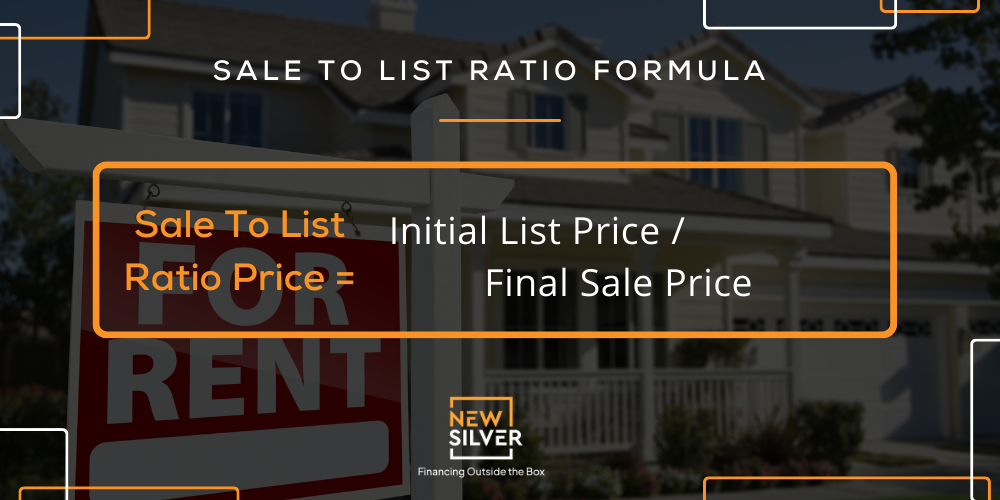A Short Summary
The sale to list ratio is a key tool for a real estate investor or other real estate professional to determine whether properties have sold for higher than their asking price, or lower. This information can indicate the local market trends, and particular investment opportunities that exist. A buyer or seller’s market is indicated by a sale to list ratio below or above 100%, respectively.
Skip To
What Does Sale To List Ratio Really Mean?
The basic definition of the sale to list ratio is a key metric that indicates how close a property’s final sale price is to its initial list price. The sale to list ratio looks at what the list price of a property was, in comparison to what it sold for, and turns this number into a percentage.
Typically, a high sale-to-list ratio would be anything over 100%, which means that the home sold for a price above its initial list price. On the other hand, a sale to list ratio below 100% indicates that the property sold for less than its listed price. This information is useful for a real estate agent, real estate professional, investor and more.
Ever heard of the list to sale ratio? This is similar to the sale to list ratio, however the concept is presented in a different order. The list to sale ratio is essentially the reverse of the sale to list ratio, with the same formula. Which means that the list to sale ratio displays the same information, and the list to sale ratio can be used interchangeably with the sale to list ratio.

How To Calculate Sale To List Ratio
Calculating the sale to list ratio is straightforward. The only numbers required are the initial list price and the final sale price. These numbers can be found through a real estate agent, or the property’s sales records, or the listing. Once you’ve found these numbers, you can work out the sale to list ratio by dividing the final sale price by the initial list price.
The sale to list ratio formula is as follows:
Sale To List Ratio = Initial List Price / Final Sale Price

Then you’ll multiply the result by 100, in order to convert this to a percentage. This step makes the number more useful but isn’t a required part of the calculation.
Example 1
Let’s say the initial list price on a property was $300,000, but the final sale price was $280,000.
Sale-to-List Price Ratio = 280,000
300,000
= 0.933
To express this as a percentage, you can multiply the result by 100:
Sale to list price ratio = 0.933 * 100 = 93.3%
So, in this example, the sale to list price ratio is 93.3%, indicating that the property sold for 93.3% of its initial listing price.
Example 2
Suppose a property’s initial list price was $400,000, but it sold for $410,000 as the final sale price.
Sale-to-List Price Ratio = 410,000
400,000
= 1.025
To convert this into a percentage, let’s multiply it by 100:
Sale to list price ratio = 1.025 * 100 = 102.5%
In this example, the sale to list price ratio is 102.5%. This indicates that the property sold for 102.5% of its initial listing price, meaning it sold for more than the seller originally asked for. This situation is often seen in seller’s markets or when there’s strong demand for the property, leading to competitive bidding among buyers.
What Does It Mean If The Sale To List Price Is Less Than 1?

A sale to list price that is less than 1 is essentially less than 100%. Which means that the property sold for less than the asking price. Usually, a sale to list price less than 1 indicates that a buyer negotiated the price with the seller and managed to successfully lower it.
When a sale to list price is less than 1 among many properties, it can indicate a buyer’s market in that area, which means that there are more houses for sale than there are buyers. This gives buyers strong negotiating power, and is important for a real estate agent to know.
The other situation that a sale to list price of less than 1 could indicate, is that the seller was motivated to get the home sold quickly. This could be due to personal circumstances, financial trouble or other reasons, that lead to a seller needing to sell the property quickly.
Sometimes a property has been overpriced, and in this case, the seller would need to drop the selling price in order to attract buyers. This can also lead to a scenario where the sale to list price is less than 1.
What Does It Mean if the Sale To List Price Is Greater Than 1?

A sale to list price that is greater than 1 (or 100%), shows that a property has sold for more than the initial list price. In other words, the final sale price exceeded what the seller originally asked for.
A sale to list price that is greater than 1 usually indicates that the property is desirable, or it has been priced effectively. This could be due to factors such as the location, condition of the property or unique features.
A sale to list price of more than 1, across many properties, can indicate that it’s a seller’s market in that area. A seller’s market is signified by more buyers in a market than properties. This can lead to bidding wars and is a great way for sellers to get a higher final purchase price on their home.
A sale to price greater than 1 can also indicate that the local market is competitive. This means that the demand for properties is high, and buyers are therefore willing to pay more than the asking price, in order to secure the deal. The result is that the selling price is higher than the asking price.
This price to list ratio can also indicate that there is limited inventory in the area, so buyers will be willing to pay a higher selling price to secure a property, meaning that the final sale price is over the asking price.
Can You Use Sale To List Ratio To Analyze Investment Properties?
The sale to list price ratio is a useful tool for real estate investors. It helps in assessing the health and trends of the housing market in the areas you operate. A rising ratio could indicate opportunities for real estate investors, while a declining ratio may require more cautious lending strategies.
In other words, monitoring this ratio can be a useful metric to consider when evaluating the potential risk and opportunity associated with financing real estate investments. For example, a sale to list price ratio above 100% can indicate significant opportunities for potential profit for investors. You can compare the Sale-to-List Price Ratio of the target property to similar properties in the area. This helps you assess its competitiveness and potential for generating profit.
Another factor that the sale to list ratio could assist with, is indicating seller motivation. If you notice a property with a low ratio and has been on the market for an extended period, it could indicate a motivated seller. This might lead to more flexible terms or lower prices, which is a key factor for an investor or real estate professional.
Bear in mind that while the sale to list ratio is a useful tool, it’s essential to consider other factors like housing market conditions, property condition, and the overall investment strategy before making decisions.


